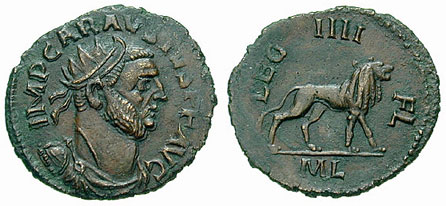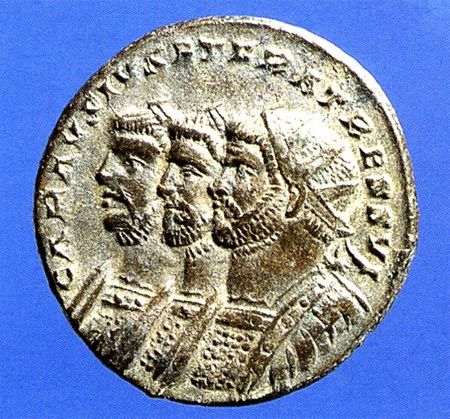
You may not have heard of Carausius, so read on to find out more about who he was.
Political chaos of the type seen around the world this year occurs in what appear to be the most sophisticated of regimes, including within the ancient world.
Following a particularly unsettled period in Roman History, Diocletian was proclaimed Emperor in 284 AD. To secure his place he appointed a trusted colleague, Maximian, as co-ruler with a remit to look after the Western half of the empire, including Britain.
One immediate task that faced Maximian was stemming the pirate raids along the coasts of northern France and Belgium. He engaged a distinguished soldier, Mausaeus Carausius, to deal with the situation, giving him command of the Roman fleet.
However, although Carausius was remarkably successful, his tactics were somewhat irregular. Rather than attacking the pirates prior to any raids he waited and intercepted them on their return journeys, relieving them of any booty. Also, he did not seem particularly keen to restore items to their original owners or to pass any treasure on to the Emperor. It was not long before Carausius’ creative approach to policing the English Channel came to the attention of Maximian, who summoned Carausius to headquarters for an explanation.
Sensing that the game was up Carausius responded by setting himself up in Britain as a third emperor (figure 1). He even issued a coin confirming this new status on which he is portrayed alongside Diocletian and Maximian surrounded by the words ‘CARAUSIUS ET FRATRES SUI’ …Carausius and his brothers! (figure 2)

There can be little doubt that Carausius was a very shrewd individual. He clearly had already gained the respect of the army in addition to the support of many Gallic merchants. But, to maintain and strengthen his position, he must have recognised the need to do much more.
During the third century, the money supply reaching Britain had become increasingly precarious with the denarius containing less than a sixth of the silver than had been the case when the Romans had first arrived in 43 AD. Cunningly, and very soon after taking control of Britain, Carausius set up mints in London and Colchester producing gold and silver coins of superb quality.
Restoring the silver currency standard was also probably a reflection of a broader aim to associate himself with traditional Roman values and virtues. He added the names Marcus Aurelius to his own and the reverses of some of this coins bore inscriptions from the great poet of the Augustan period, Virgil such as ‘EXPECTATE VENI’ (Come, O expected one) or RSR (The Golden Age is back) . Many other pieces also make references to peace, plenty, happiness or restoration.
At Malton, the North-East gate of the fort was probably rebuilt by Carausius, based on the finds from the 1927-30 excavations (including 23 coins of the Carausian period). Down the road at Brough it seems likely that there was also significant building activity at the same time. Elsewhere there is evidence that new defensive shore forts were being established at Porchester while others at Brancaster and Lympne were being restored or repaired.
Undoubtedly all this construction work would have made the inhabitants of places such as Malton feel more secure. There might also have been a sense that Britain had ‘taken back control’ rather than being subject to Imperial edicts emanating from the far-flung Roman administrative centres at Trier and Milan. Perhaps the splendid decoration of the town house in the vicus at Malton reflects the improved confidence and circumstances for the residents of Northern Britain.
However, after seven years, Carausius came to a sticky end, being assassinated by his finance minister Allectus. By 296 the game was up for Allectus too, who was killed in a battle with Asclepiodotus, the praetorian prefect. As beautifully illustrated on a large golden medallion unearthed in Arras a hundred years ago, Diocletian’s new co-emperor Constantius (the father of Constantine the Great) was welcomed into London and Britain returned to the Roman Empire.
Figure 1: Coin with an image of a tough-looking Carausius and the lettering IMP (emperor) before his name. The inscription on the reverse refers to the 4th Roman legion that provided him with troops. ML is the mark of the London mint.
© Classical Numismatic Group, Inc. http://www.cngcoins.com, CC BY-SA 3.0, https://commons.wikimedia.org/w/index.php?curid=348487
Figure 2: Coin of Carausius from a hoard discovered in Wales. On this piece he is shown on the left next to Diocletian (centre) and Maximian. ©National Museum of Wales
Visit: National Museum of Wales

You might be interested in my Carausius story on my website
[…] The basilica and forum lasted for over 200 years until they were destroyed, not by an alien force but by Rome itself as punishment for London supporting the rule of the “rogue emperor” Carausius. […]